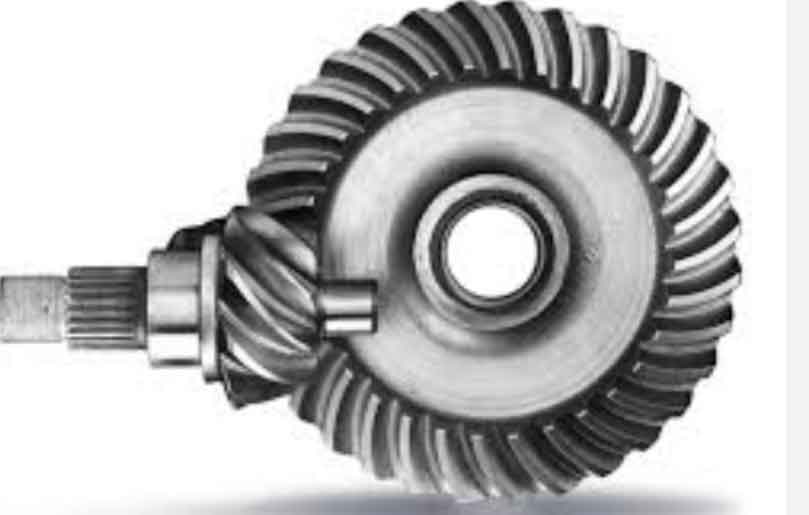This paper proposes a novel method for constructing digital real tooth surfaces of hypoid gears with wear patterns, combining non-geometric-feature data segmentation and improved interpolation algorithms. The approach addresses critical challenges in dynamic performance prediction for hypoid gears operating under real-world conditions.
1. Theoretical Foundation
The mathematical model of hypoid gear tooth surfaces in coordinate system $S_g$ is expressed as:
$$ \mathbf{r}_g(u, \theta) = \mathbf{M}_{gt}\mathbf{r}_t(u_t, \theta_t) $$
$$ f(u_t, \theta_t, \phi) = \mathbf{N}_t \cdot \mathbf{V}_{tg} = 0 $$
where $\mathbf{M}_{gt}$ represents coordinate transformation matrices, and $f$ denotes the meshing equation.

2. Key Technical Innovations
2.1 Non-geometric-feature Segmentation
The segmentation algorithm evaluates triangular mesh elements using:
$$ T = \max(\delta_{12}, \delta_{23}, \delta_{31}) – \min(\delta_{12}, \delta_{23}, \delta_{31}) $$
where $\delta_{ij}$ represents angular differences between adjacent triangular patches. This enables automatic identification of wear regions through iterative boundary expansion.
2.2 Enhanced Local Interpolation
The improved NURBS interpolation algorithm incorporates error compensation:
$$ \sum B_{i,k}(u)\omega_i(V_i + \Delta V_i) = \mathbf{P}(u) + E(u) $$
With control vertex adjustment calculated through:
$$
\begin{bmatrix}
b_{1,2} & b_{1,3} & 0 \\
b_{2,2} & b_{2,3} & b_{2,4} \\
0 & b_{3,3} & b_{3,4}
\end{bmatrix}
\begin{bmatrix}
\Delta V_2 \\
\Delta V_3 \\
\Delta V_4
\end{bmatrix}
=
\begin{bmatrix}
a_1\Delta E_1 \\
a_2\Delta E_2 \\
a_3\Delta E_3
\end{bmatrix}
$$
2.3 Surface Fairing Algorithm
The curvature-based fairing process maintains wear pattern fidelity while improving surface smoothness:
$$ \kappa(u_i) = \frac{|\mathbf{\dot{P}}(u_i) \times \mathbf{\ddot{P}}(u_i)|}{|\mathbf{\dot{P}}(u_i)|^3} $$
Vertex relocation follows:
$$ V_j’ = \frac{(t_{j+2} – t_j)l_j + (t_j – t_{j-2})h_j}{t_{j+2} – t_{j-2}} $$
3. Experimental Validation
Comparative analysis of hypoid gear pairs (Table 1) demonstrates the method’s superiority over conventional area-weighting interpolation:
| Parameter | Pinion | Gear |
|---|---|---|
| Number of teeth | 6 | 37 |
| Module (mm) | 8.243 | – |
| Face width (mm) | 45.12 | 40 |
Surface accuracy comparison reveals significant improvements:
| Method | Max Error (μm) | Average Error (μm) |
|---|---|---|
| Area-weighting | 21.8 | 12.4 |
| Proposed method | 3.6 | 1.8 |
4. Computational Efficiency
The non-feature segmentation reduces computational complexity from $O(n^2)$ to $O(n\log n)$ through:
$$ T(n) = C_1n\log n + C_2k $$
where $k$ represents the number of wear regions, typically less than 5% of total data points in hypoid gear applications.
5. Industrial Applications
This methodology enables:
- Accurate prediction of hypoid gear transmission error under wear conditions
- Precision remanufacturing of worn hypoid gear pairs
- Virtual testing of lubrication performance for worn gear surfaces
6. Conclusion
The proposed framework advances hypoid gear technology by:
- Implementing adaptive data segmentation for wear pattern recognition
- Developing error-compensated local interpolation algorithm
- Establishing curvature-constrained surface fairing process
Experimental results confirm the method’s effectiveness in maintaining surface accuracy below 4μm while preserving critical wear pattern information essential for dynamic performance analysis of hypoid gear systems.
